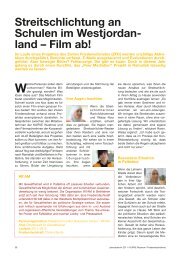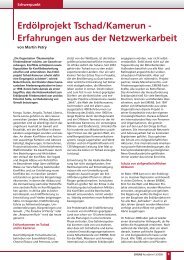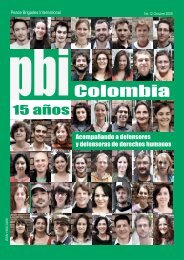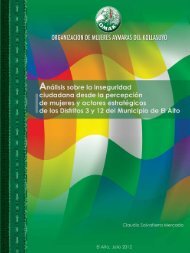Merging Ethiopian Wise-Counsel Mediation and Facilitative ...
Merging Ethiopian Wise-Counsel Mediation and Facilitative ...
Merging Ethiopian Wise-Counsel Mediation and Facilitative ...
- No tags were found...
Create successful ePaper yourself
Turn your PDF publications into a flip-book with our unique Google optimized e-Paper software.
Triad Tool: Observe-Interpret-InterveneMediators want to support parties in their return to creativity <strong>and</strong>constructiveness by being empathic <strong>and</strong> underst<strong>and</strong>ing. This tool helpsto avoid hasty judgements <strong>and</strong> enables the mediator to intervene accurately<strong>and</strong> skilfully. It is also helpful in preventing deadlocks <strong>and</strong> the lossof all-partisanship due to misinterpretations. A misjudged interventionthreatens the relationship between the mediator <strong>and</strong> the conflict parties.Therefore, it is useful to sharpen your ability to observe before you intervenein order to avoid misled statements or actions. These three steps arerecommended in dealing with non-verbal signals:1. Closely observe the parties.2. Develop several theses.3. Intervene.By following these, the mediator becomes aware of the danger ofmixing up observation with interpretation <strong>and</strong> becomes open for alternativeinterpretations.E.g. X—a party to the mediation process—shifts his eyes to the side,takes a deep breath, purses his lips <strong>and</strong> caresses the left thumb with theright thumb of his folded h<strong>and</strong>s. A possible reaction could be, “Aha, X isimpatient <strong>and</strong> irritated.” At this point, the different levels of observation<strong>and</strong> interpretation have unconsciously been mixed <strong>and</strong> become one. Themediator might even unknowingly already give a nonverbal response,<strong>and</strong> the perceived impatience of X becomes a fact, even though he mighthave had other reasons for his behaviour.Alternatively, following the triad-tool steps, the mediator might firstsimply observe <strong>and</strong> describe what has changed: “X turned his eyes away,his h<strong>and</strong>s are folded…” The mediator is not interpreting or judging atthis point. By doing so, he/she dissociates herself from the scene <strong>and</strong>creates time <strong>and</strong> space for alternative interpretations.With an open view she can then, in step two, develop of a varietyof theses: “X is focusing on himself; he is impatient; he is nervous; heis aggressive; he wants to hang on to something; he does not want toreply; he is calming himself down; he just had an idea”; etc. This openperspective influences her own attitude since he/she is now able to verifyher theses in a relaxed mood.When he/she intervenes in step three, she tests the possible interpretations.She might combine several theses by asking, “I wonder whetheryou just had a new idea or whether you wish to proceed in a faster way?”Sometimes it is also helpful to only verbalise observations in a question:“I can see that you have a little smile on your lips…?” The mediatormust be very careful with this approach as speaking about unconsciousbehaviour is a sensitive issue <strong>and</strong> can lead to giving someone the feelingof being caught. It might help not to give a full description in order notto embarrass the person. The question should serve as an invitation forX to reflect on himself or to explain his feelings. The mediator may alsorealise that certain theses are coined by her own feelings rather than by X.Step 1: Descriptive observationsNo judgement, no interpretation.Step 2: Development of thesesInterpret the observations in several theses.Step 3: InterventionReality check for theses <strong>and</strong> interpretation.Internal action:Self-managementExternal action:e.g. Verbalising/mirroring<strong>Mediation</strong> Training Toolbox63
















